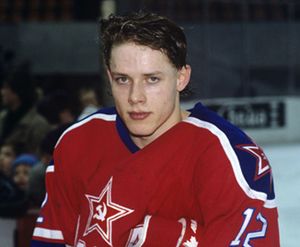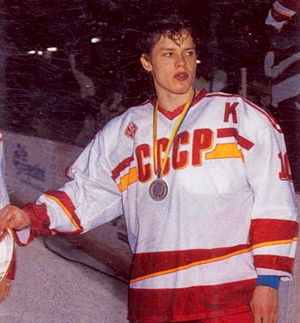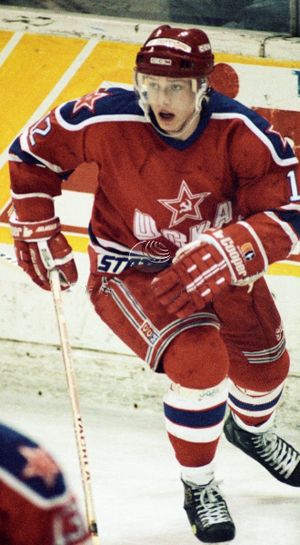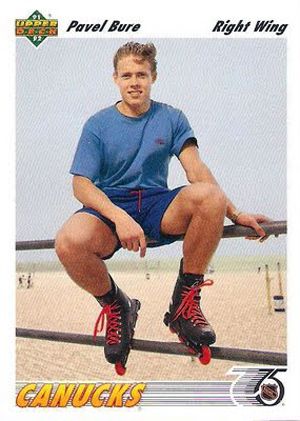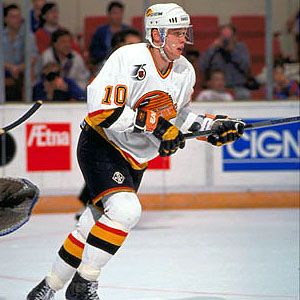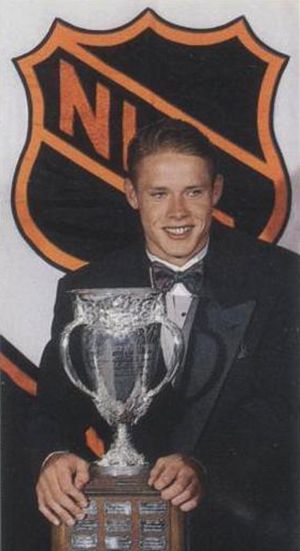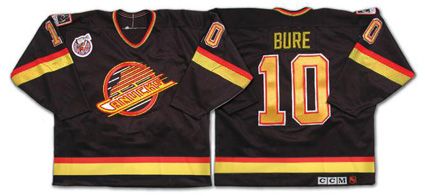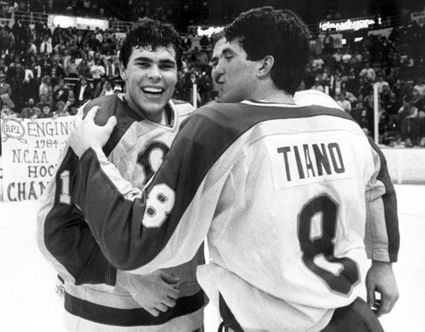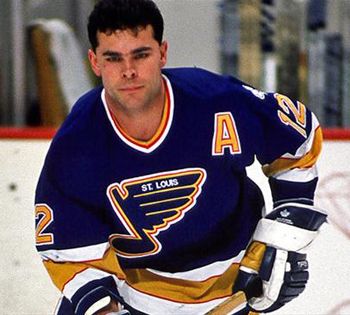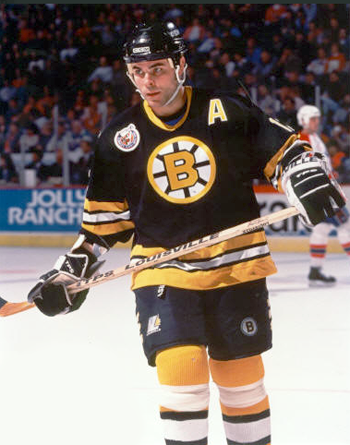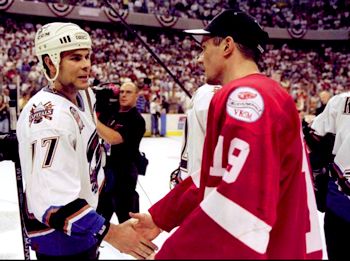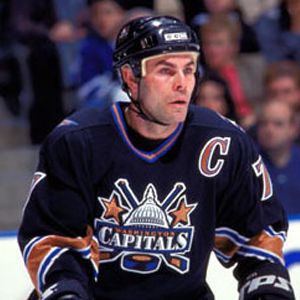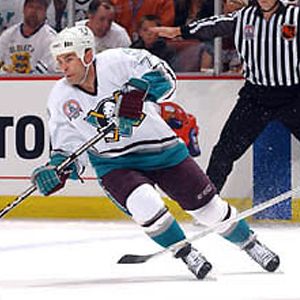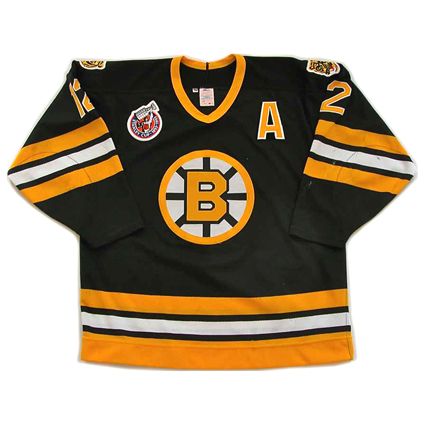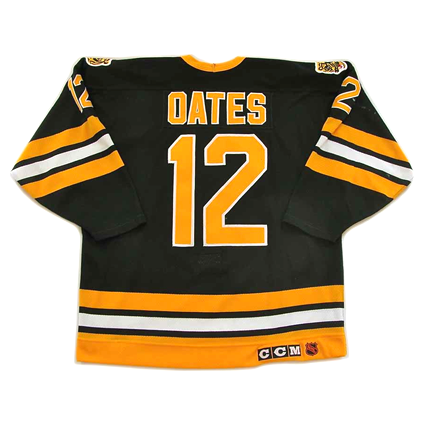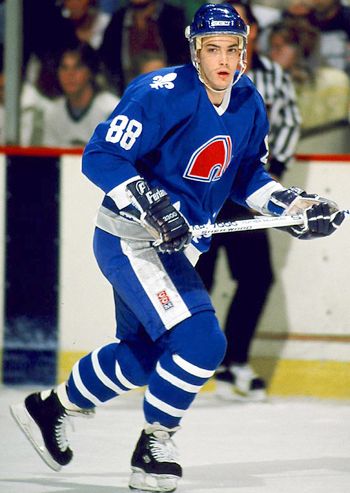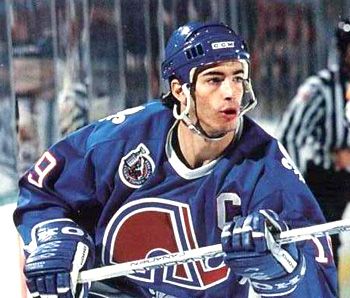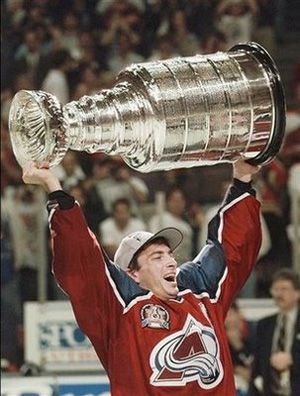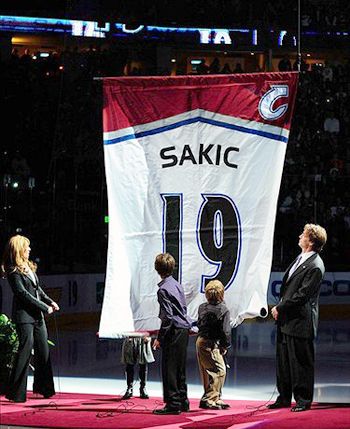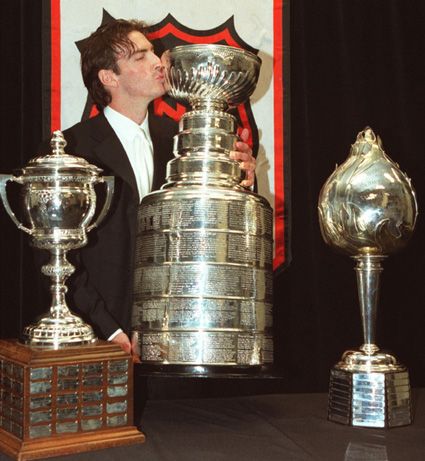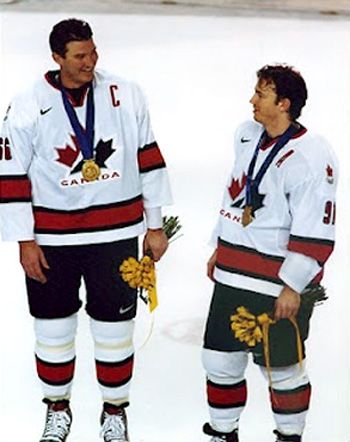Friday, June 29, 2012
1992-93 Vancouver Canucks Pavel Bure Jersey
Named as one of the four inductees into the Hockey Hall of Fame this past Wednesday, Pavel Bure was once selected to practice with Wayne Gretzky and Vladislav Tretiak for a television program at the age of 11. By the age of 14, Bure was named to the famed Central Red Army's junior team.
In 1986, five years before playing in Vancouver as a professional, Bure toured Canada with a Soviet youth team and played a game at the Pacific Coliseum, his future home rink.
He made his debut with the Central Red Army senior club in 1987-88 at the age of 16 as a fill-in player when the Red Army Club was without several regulars who were participating in the 1987 Canada Cup. In all, he managed to get into five games, which included scoring his first goal.
While with CSKA Moscow, Bure was teamed with Alexander Mogilny and Sergei Fedorov, a dangerously potent line combination that was set to dominate not only Soviet hockey, but international hockey for years to come, until politics interfered and changed everything.
Bure set a Soviet League record for goals by a rookie in 1988-89 when he totaled 17 goals in 32 games, a mark that would stand for 18 years as CSKA continued their dominance by winning the league championship for the 13th consecutive season. He was recognized for his for his efforts by being named the league's rookie of the year. He also participated in the 1989 World Junior Tournament, with his eight goals tying for the tournament lead. Additionally, his 14 points led the competition in scoring, earning him Best Forward honors while leading the Soviet Union to the gold medal.
Mogilny would later defect after that spring's World Championships in Sweden, breaking up the line the Soviets expected would lead them into the future.
Later on June 17, 1989, thanks to some detective work by their head scout, the Vancouver Canucks were able to draft Bure one year earlier than many thought he would be eligible due to a rule that stated he needed at least two seasons of play, with a minimum of 11 games each season, for his top-level European club.
Although Bure only played in five league games, it was discovered he had also competed in enough exhibition and international games to make him eligible to be chosen 113th overall in the 6th round. The Detroit Red Wings had even been told by an NHL vice-president that Bure was not eligible prior to their fifth round pick. Verbal complaints and written protests followed, which resulted in a formal investigation, which ended in league president John Ziegler declaring the pick illegal on May 17, 1990.
Bure would compete in the 1990 World Junior Championships, this time scoring seven goals in seven games, but come up short with a silver medal. Later that spring he made is debut with the Soviet National Team as a 19-year-old at the World Championships in Switzerland in which he scored six points in ten games on the way to a gold medal.
Pavel Bure at the 1990 World Junior Championships
Another international tournament was on the calendar for 1990, this time in Seattle, Washington for the Goodwill Games. While the Soviet Union won the gold medal, and Bure contributed four goals and an assist in five games, the tournament is best remembered for the defection of Bure's other linemate, Fedorov, who tried to persuade Bure to defect with him. Bure declined out of concern for repercussions against his brother Valeri, who was then an up and coming 15-year-old in the Soviet Union.
After the Canucks selection of Bure was negated by the league's ruling, Vancouver appealed to the league and provided game sheets proving his participation in the required number of games. On June 15, 1990, the day before that year's Entry Draft in which Bure would have been fair game for any team who wished to select him, Vancouver's selection of Bure was permanently reinstated.
In Bure's third season with Central Red Army in 1990-91, he tied for the team lead in scoring with 46 points in 44 games. His 35 goals were one behind the league leader in that category. During the season he also participated in his third World Junior Championships. Bure finished as the tournament's leading scorer once more following his 12 goal, 15 point effort, but had to once more settle for a silver medal. He concluded his junior career with a tournament record 27 goals.
Bure as a member of the famed Central Red Army team
Later that spring he participated in the 1991 World Championships where he tied for the team lead with 11 points in 11 games on his way to a bronze medal finish.
Bure left Moscow on September 6, 1991 and the Canucks began to negotiate a contract with him, but before it could be finalized, the Canucks also had to deal with the Central Red Army club, who had an existing contract with Bure. The two sides met in late October of 1991 in Detroit and in the end, Bure was free to join the Canucks following a $250,000 payment to Central Red Army. Once that deal was settled, Bure signed a four year contract with Vancouver, making him the second highest paid player on the team behind only team captain Trevor Linden.
Due to the court proceedings, Bure missed the first month of the season and eventually made his NHL debut on November 5, 1991 against the Winnipeg Jets which ignited "Pavel-mania". His speed on the ice was eye-catching and led to his eventual nickname of "The Russian Rocket".
Prior to his NHL debut, Bure poses for one of
Upper Deck's unconventional "lifestyle" cards
After a 4-3 win over the Los Angeles Kings on November 7th, Bure got his first NHL point on November 10th with an assist on a goal by Cliff Ronning in a 6-0 win over the New York Islanders. As he adjusted to life in North America and the NHL style of game, he was able to score 12 goals in 42 games. It was at that point that Bure caught fire and surged to the end of the season with a stellar 22 goals in his final 23 games, which sent Vancouver into a frenzy and gave him 34 goals and 60 points in 65 games, which tied a team record for points by a rookie.
Bure as a rookie in 1991-92
Once in the playoffs, Bure registered his first hat trick during Game 6 of the Canucks opening round series against Winnipeg. The Canucks would participate in two rounds of the playoffs that season, with the confident rookie scoring 6 goals and 10 points in 13 games.
At the conclusion of the season, Bure was named the winner of the 1992 Calder Trophy as NHL Rookie of the Year, the first Canuck's player to win an individual award in the team's 21 seasons.
Bure poses with the Calder Trophy
Now with a full year of experience and confidence under his belt, Bure got off to a flying start, scoring a career high four goals in only the third game of the season. He also set Canucks team records for goals and points in a period when he scored three goals and added an assist during the second period of the Canucks game against the Winnipeg Jets. Additionally, his four goals set a team record for goals in a game and shorthanded goals in a game, as two of Bure's goals came with the Canucks a man down.
That season he participated in his first NHL All-Star Game, scoring twice for the Campbell Conference. Not long after the all-star game, Bure set the Canucks team record for goals in a season with his 46th goal, passing Tony Tanti's mark of 45. He continued to light the lamp at a furious pace, hitting the 50 goal mark on March 1st in a neutral site game in Hamilton, Ontario against the Buffalo Sabres.
March 9th saw Bure pass Patrik Sundstrom's franchise record of 91 points with a pair of assists in a 7-2 win over the New Jersey Devils before reaching the rarified air of the 60 goal plateau, which he accomplished during a 6-3 win over the Calgary Flames. Bure would finish his sophomore season with exactly 60 goals and 50 assists for 110 points.
He duplicated the 60 goals again the following season as part of a nearly identical 107 point season in 1993-94, and added another 16 goals and 31 points in 24 games as he led the Canucks to the Stanley Cup Finals. He would play four more seasons with the Canucks, including scoring 51 goals in his final season in Vancouver in 1997-98.
He only played 11 games during his first year with the Florida Panthers, but was worth the wait when he unleashed back to back 58 and 59 goal seasons in 1999-00 and 2000-01, leading the league in goals both times.
The Panthers acquired his brother Valeri in 2001-02, but after 56 games, during which he scored 49 points to lead the Panthers for the season, he was traded to the New York Rangers in March. More knee injuries limited him to just 39 games in 2002-03 and forced him to miss the 2003-04 season. After the 2004-05 season was canceled due to the lockout, the additional time off still did not allow Bure to return to full health and he announced his retirement in November of 2005.
In 12 NHL seasons, Bure played in 702 games, scoring 437 goals and 779 points and played in six NHL All-Star Games, including being named the game's MVP in 2000.
Internationally, Bure played in three World Juniors, winning gold in 1989 and silver medals in 1990 and 1991. At the World Championships, he won gold in 1990 and a silver in 1991. Eligible for the Olympics thanks to the NHL's full cooperation, he was able to earn a silver in 1998, along with being named the tournament's Best Forward, and a bronze in 2002. Earlier this year, Bure was inducted into the International Ice Hockey Federation's Hall of Fame.
Today's featured jersey is a 1992-93 Vancouver Canucks Pavel Bure jersey as worn during his second season in the NHL during which he scored 60 goals on this date in 1991.
This jersey features the Stanley Cup Centennial patch on the right chest as worn by all players in the NHL that season. This style of jersey was adopted in 1989 and worn through the 1996-97 season, with the only notable change being the addition of the "Canuck Place" patch in 1992.
Photo courtesy of Classic Auctions
Bonus Jersey: Today's bonus jersey is a 1991 Soviet Union Pavel Bure jersey. Following Adidas in the mid to late 1980's, the Finnish brand Tackla became the supplier for the World Championships and Olympics through 1993. Their jerseys featured mesh fabric and classic styling (for the most part), with contrasting colored shoulders which contained repeating diamond shapes, which is the Tackla company logo.
Their jerseys are also instantly recognizable by their block font numbers with the "3-D" drop shadow effect. These jerseys are all sublimated, and therefore age very well, retaining their bright colors over time.
Jerseys worn in 1994 and 1995 were branded as Reebok jerseys, but have all the hallmarks of being produced by Tackla, the dye-sublimated mesh fabric and 3-d block numbers, especially the logo on the lower left hem on the back which reads "manufactured by Tackla"!
In today's video segment, a look at what could have been, with Bure, Mogilny and Fedorov playing together at the 1989 World Junior Tournament.
Next, a look at "Pavel-mania" during Bure's rookie season, including footage of his first NHL game and his first two NHL goals.
Labels:
Bure Pavel,
Vancouver Canucks
Thursday, June 28, 2012
1992-93 Boston Bruins Adam Oates Jersey
On Tuesday, the Hockey Hall of Fame announced its inductees for 2012, and included in the group of four players was Adam Oates, a Canadian, who took the less travelled route to the NHL at the time by playing college hockey in the United States. While with Rensselaer Polytechnic Institute, more commonly known as RPI, where he helped win the 1985 NCAA Championship. He graduated with school records for most assists, setting the tone for his NHL career in the process, with 60, points in a season with 91 and career points with 150.
Oates celebrates RPI's national championship
After RPI's championship season, Oates signed as an undrafted free agent with the Detroit Red Wings. He would play four seasons in Detroit before being traded to the St. Louis Blues and beginning his journey around the league. Upon his arrival in St. Louis, he would be paired with Brett Hull, a move that enabled him to immediately score over 100 points for the first of four times in his career, a 24 point improvement over his final season with the Red Wings. During his second season in St. Louis, 1990-91, he would accumulate 90 assists despite playing in only 61 games, which allowed him to raise his career best from 102 points up to 115.
Following a contract hold out the following year, he would continue his trek when he was traded to the Boston Bruins. He would show St. Louis the error of their ways with a career high 45 goals and 145 points to finish third in league scoring in 1992-93, a position he would repeat the next season with 32 goals and 80 assists for 112 points.
Oates during his career best season in 1992-93
The relationship with the Bruins soured and Oates would once more be on the move three seasons later, this time to the Washington Capitals, where he would change his jersey number from #12 to #77 in honor of Bruins teammate Ray Bourque, who remained in Boston.
In Oates first full season in Washington, the Capitals would make it all the way to the 1998 Stanley Cup Finals before falling to his former club, the Red Wings.
Oates shakes hands with Steve Yzerman following the 1998 Stanley Cup Finals
Oates would play six seasons for the Capitals, including being named team captain in 1999. He led the league in assists in 2000-01 and would repeat that feat again the following season, becoming the oldest player to ever do so at age 39. That season would also see him score his 1,000th assist, becoming only the eighth player in NHL history to reach that milestone.
Oates as captain of the Capitals
However, Oates would once again be traded, finishing the season by playing 14 games with the Philadelphia Flyers. 2002-03 would see Oates return to the Stanley Cup Finals for the second time, now with the Mighty Ducks of Anahiem, before falling in seven games to the New Jersey Devils.
Oates while with the Mighty Ducks
2003-04 would see him add one last opportunity to add to his sweater collection, as he would dress for his seventh and final club, the Edmonton Oilers. His final career totals would stand at 341 goals and 1079 assists for 1420 points in 1337 games and Oates would play in five NHL All-Star Games. His playmaking ability would see him total more assists in the 1990's than any other player, save for Wayne Gretzky. Oates had the most points of any eligible player not in the Hockey Hall of Fame up until his election this week.
In addition to being voted into the Hockey Hall of Fame Oates' memorable day continued with him being named head coach of the Washington Capitals, his first NHL head coaching position.
"Obviously, a fantastic day. I don't know if that's happened before," Oates said of being picked for induction and hired as a coach on the same day. "It's just a special, special day for us."
Today's featured jersey is a 1992-93 Boston Bruins Adam Oates jersey as worn during Oates career best season during which he had a career high of not only 45 goals, but also 97 assists for 142 points.
The Bruins wore this jersey style for the first time in 1974-75, adding shoulder patches in 1976 and names on the back a year later. The jerseys then remained unchanged all the way through the 1994-95 season, and frankly never should have been replaced, as they would now be on the same plane as the unchanging sweaters of the Red Wings, Blackhawks, Rangers and Canadiens.
Here is Oates talking about his favorite memories of playing in St. Louis.
Uh, yea...
And a few less speaking lines this time around...
That's really about it for Oates on YouTube. He has over 1,000 NHL assists, will now be in the Hall of Fame, yet can't get on YouTube, so here's your homework assignment - someone needs to make a career highlight video of Adam Oates and his undeniable playmaking abilities.
Labels:
Boston Bruins,
Oates Adam
Wednesday, June 27, 2012
1995-96 Colorado Avalanche Joe Sakic Jersey
The Hockey Hall of Fame announced it's 2012 inductees, which included Stanley Cup champion Joe Sakic.
Sakic was originally drafted by the Colorado Avalanche franchise when they were still the Quebec Nordiques 15th overall in the 1987 NHL Entry Draft.
A little known fact is that Sakic's parents were Croatian immigrants and he grew up speaking Croatian before attending elementary school. He would be named Rookie of the Year in the Western Hockey League of Canadian Juniors in 1987 after scoring 133 points. He also survived a horrific bus crash involving his club, the Swift Current Broncos, in which four of his teammates were killed. The following year Sakic was named WHL Most Valuable Player and Canadian Major Junior Player of the Year after scoring 160 points.
He scored an assist on his NHL debut on October 6, 1988 versus the Hartford Whalers and originally wore sweater #88 because Alain Cote was wearing his preferred #19. He finished with 62 points in 70 games.
Sakic wearing #88 as a rookie
With Cote now retired, Sakic claimed his #19 for 1989-90 and scored 102 points. 1990-91 saw Sakic score 109 points, sixth overall in the league, and be named co-captain of the Nordiques (for home games).
Sakic would miss 11 games in 1991-92, which would hurt him in his chances to repeat another 100 point season, and he would conclude the year with 94 points. During this time period. the Nordiques regularly finished in last place, which allowed them to load up on high draft choices and put them in position to acquire a number of talented players, highlighted by their trade of holdout Eric Lindros.
Now named full time team captain of the newly reconfigured Nordiques, Sakic would respond in 1992-93 with 105 points and lead the Nordiques out of the wilderness and into the playoffs for the first time in his career on the heels of a staggering 52 point improvement, double their total of the year prior. Without any previous playoff experience, the Nordiques would be eliminated in the first round by arch-rivals the Montreal Canadiens.
1993-94 was a slight step back for Sakic, as he would fall short of the 100 point barrier with 92, but the Nordiques would take a large step back, dropping 28 points in the standings and miss the playoffs yet again.
The Nordiques final season of in Quebec saw Sakic finish fourth in scoring during the lockout shortened 1994-95 season and the Nordiques would capture the division title, only to be eliminated in six games by the New York Rangers, ending their time in Canada.
Relocated to Denver, the Colorado Avalanche took to the ice in the 1995-96 season hoping to continue the improvement shown during Sakic's seven seasons in Quebec. Little did anyone anticipate the events that would unfold that season.
After having a major falling out with the Montreal Canadiens, superstar goaltender Patrick Roy was traded to the Canadiens former arch-rivals, now located in Colorado, a trade which would have never, ever happened had the club remained in Quebec, and the Avalanche were now on their way to glory.
Sakic topped 50 goals for the first time with 51, adding 69 assists for a career high 120 points for third in the league. The Avalanche would storm the playoffs, defeating first the Vancouver Canucks, followed by the Chicago Blackhawks by identical 4 games to 2 margins. Next up was a hard fought series with the Detroit Red Wings, upsetting the team that finished 27 points ahead of them in the standings 4-2 for the right to face the upstart Florida Panthers, whom they easily dismissed in four straight games for the the franchises first Stanley Cup Championship in their first season out of Quebec. Sakic would lead the playoffs in scoring that season and be named the winner of the Conn Smythe Trophy.
It had been a long journey for Sakic, who, along with Curtis Leschyshyn, were the only two Nordiques players from the 1988-89 season to suffer through the years of last place finishes to eventually raise the Stanley Cup.
Sakic with the Stanley Cup in 1996
Sakic would eventually play 13 seasons in Colorado, scoring 100 points twice more in his career, eventually surpassing the 600 goal, 1,000 assist and 1,600 point marks. His 16 years as captain of the franchise is the second longest tenure in NHL history and his outstanding career with the Avalanche was recognized when his #19 was retired by the club in 2009.
While Sakic played in Colorado, the Avalanche were regular fixtures in the playoffs, and contenders for the Stanley Cup for seven straight seasons, reaching the conference finals in six of those seven seasons, including winning the Stanley Cup again in 2001, the same season he won the Hart Trophy as league MVP, the Pearson Award and the Lady Byng Trophy.
Sakic with the Lady Byng, Stanley Cup and Hart Trophy in 2001
Internationally, Sakic was a member of the Canadian National Team that won the World Junior Championship in 1988, the 1994 World Championship, the 2002 Olympics and the 2004 World Cup of Hockey. Sakic also won a silver medal at the 1991 World Championships and was captain of Team Canada at the 2006 Olympics in Italy. His Stanley Cup championship, World Championship and Olympic gold medal made him one of the first group of Canadians to become a member of the Triple Gold Club in 2002.
Mario Lemieux with Sakic after receiving their gold medals in 2002
Today's featured jersey is a 1995-96 Colorado Avalanche Joe Sakic jersey and features the 1996 Stanley Cup Finals patch. This jersey stands apart with it's "mountain range" striping on the waist and arms, unlike any other jersey of it's day. Combined with it's unique color palette, custom number font, memorable secondary shoulder logos and the club's success on the ice, this style Colorado Avalanche jersey is a true icon of it's era and only the change to the templated Reebok Edge jerseys killed off what would have likely been one of those jerseys that lived on unchanged for years.
The white names and numbers on this jersey have a textured herringbone pattern pattern to them, which is called "Glacier Twill". In addition to that detail, the silver outline around all the numbers is a metallic silver material, which is often done as a flat grey material on Avalanche jerseys. The lettering for the name is also tall and narrow, as shown by the shape of the "C", which is also often found as a nearly perfect circle shape with rounded, instead of flat sides like shown here.
Our first video today are the Top 10 things about Joe Sakic.
Our second video is a tribute video dedicated to his entire career on the occasion of his retirement.
Labels:
Colorado Avalanche,
Sakic
Subscribe to:
Comments (Atom)

